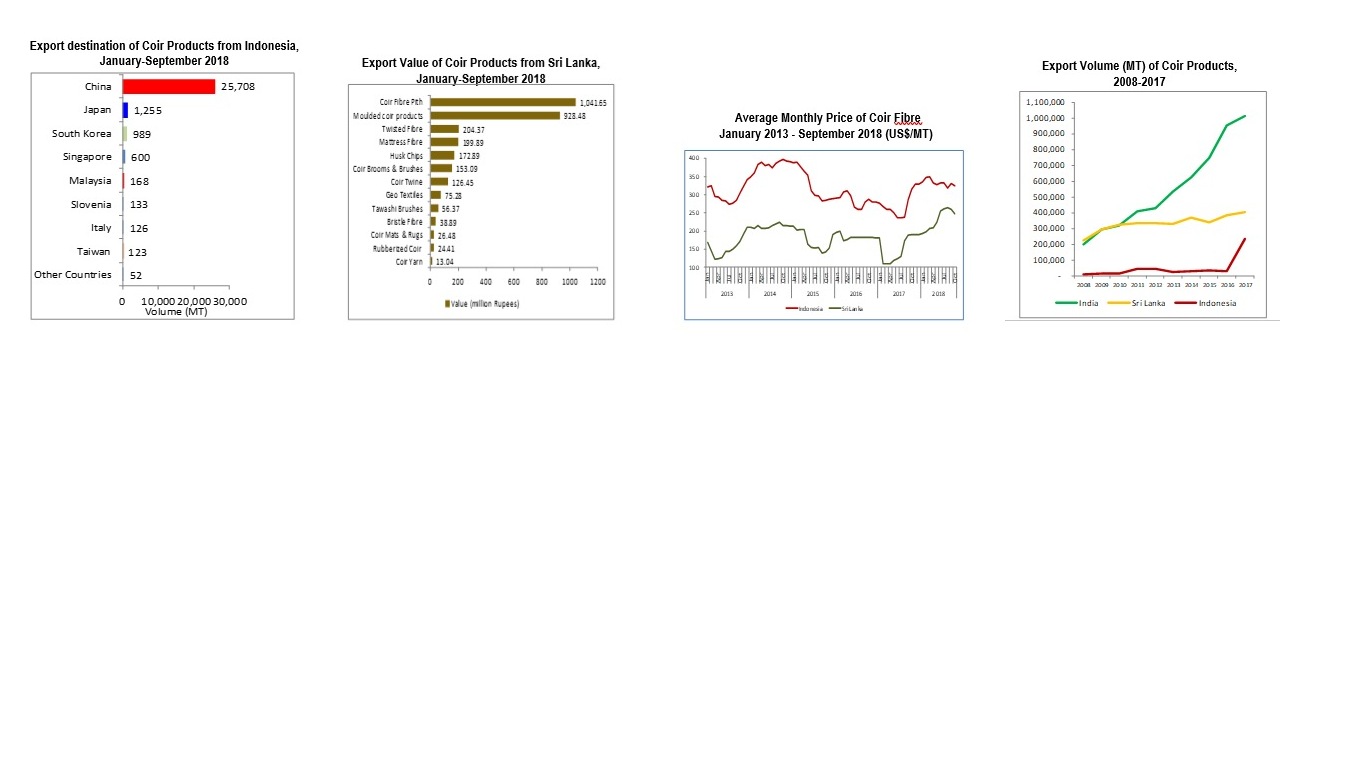MARKET REVIEW OF COIR
November 2018

India, Sri Lanka and Indonesia are still dominating global market of coir products. Approximately more than 85% of the total exports are sent from these countries. The rest are shared by Thailand, Philippines and Malaysia. The strength of India in its domestic demand was well combined with the growth of its export. Indian export of coir products was only around 200 thousand MT in 2008/09 and increased exponentially to more than 1 million MT in 2017/18 with growth average of more than 20% per annum. Meanwhile in 2017, Sri Lanka’s export increased by 11% in value in the period of January to December. The export was dominated by finished products such as fibre pith, moulded coir products and coir broom and brushes which contributed more than 82% of the total export. India and Sri Lanka emphasize more on value added products. Meanwhile, Indonesia is still struggling to develop its coir industry which currently mainly produces raw fibre. China is still a major importing country for coir products as its current share in the global market is more than 50% of the world import and still improving though in limited pace. Coir industry, in general, keeps showing a positive growth in global market especially for value added products. Currently global trade of coir fibre and its value added products such as yarn, matting, rugs and carpet as well as geo textile is estimated worth more than one billion US dollar.
Exports of coir products from India continue to grow as the global market for coir and coir products is improving. The latest data from Coir Board of India show that in the period of April 2017-March 2018, a total quantity of 1,016,564 MT of coir and coir products were shipped from India globally. The export valued at Rs. 253,228 lakhs or equal to US$ 357.28 million. Such export revenue increased by 11% from the previous year for the same period. The revenue might still be improving due to a growing demand from importing countries, such as China and USA for coir and coir products from India.
India as a leading exporter country sends 14 coir product categories to the world market. These include semi finished products such as coir yarns, loom mats and mattings, and rubberized coir to finished products like geo-textiles, coir rugs and carpets. In the period of April 2017-March 2018, export volume of coir products from India was recorded at 1,016,564 tonnes or went up by 6.2% from 957,045 tonnes for the same period in 2016/17. Exports of coir products from India were still dominated by coir pith and coir fibre. The two coir products constituted for 90.8% of the total export volume of coir products. Coir fibre grew by 1.1% to 374,320 tonnes from 370,357 tonnes in 2016/17. Meanwhile, coir pith increased by 11.8% in the same period. Coir rugs and carpet recorded the highest export growth accounting for 24% in volume. USA, Netherland, China, South Korea, Spain and Italy were still the main destination of coir products from India.
China-dependent is still perceived for market of coir product from Indonesia. Until the third quarter of 2018, China absorbed 88% of Indonesian coir products. The product was still dominated by raw coir fibre in bales. In the period, total export of coir product from Indonesia was 29,152 MT which was equivalent to US$7.99 million. Other destinations for coir fibre from Indonesia were Japan, South Korea, Singapore and Malaysia.
During January-September 2018, export value of coir products from Sri Lanka was US$143.65 million which was 3.1% lower than 2017’s export value for the same period. Coco pith contributed the highest revenue of Sri Lanka coir products which accounted for 39.3% of the total export revenue. Coco pith which has been mostly used as agriculture planting media, fertilizer, animal feed and sometimes bedding for the animal pens. Japan was still a major importer of Sri Lanka’s coir pith. In the period of January- September 2018, Japan imported 32,623 tons or 22.4% of the Sri Lanka’s total export of coco pith at 145,383 tons. Other major markets of Sri Lankan coco pith included Mexico, South Korea, USA, UK and China. They imported coco pith ranging from 8,250 tons to 15,740 tons during the period. Compared to the previous year, export volume of coco pith demonstrated a negative growth of 7%. Furthermore, in the same period, coir mattings and rubberized coir pads & mattress for bedding were the Sri Lankan coir products that showed the highest increase in volume compared to the same period in the previous year. The products recorded 690% and 315% increase in volume respectively.
As global demand showed a positive growth, an upturn trend of coir fibre price revealed. After experiencing a decreasing trend from 2016 to the first half of 2017, price of coir showed a reverse trend in the second half of 2017. The increasing trend persisted in the first half of 2018. In Sri Lanka, the average price of raw fibre reached US$255/MT in June 2018 which was 107% higher than the price in the same month last year. The increasing trend was actually perceived from May 2017 and gradually increased to reach US$193/T in January 2018. The price further increased to reach the highest level in June 2018. While the price of coir fibre in Indonesia started to regain in August 2017 of US$238/MT and reached US$315/MT in October 2017. The price continued to go up reach the level of US$333/MT in June 2018. Price of coir fibre showed a relatively stable trend until the third quarter of 2018. In Indonesia, monthly average of the price was US$333/MT during January-October 2018 and in Sri Lanka, the average was US$232/MT.


